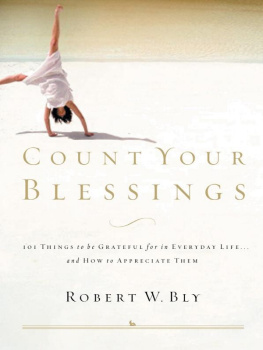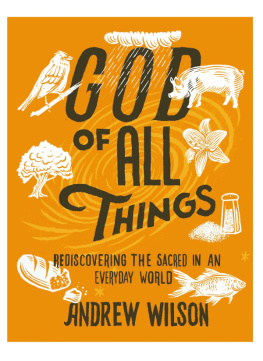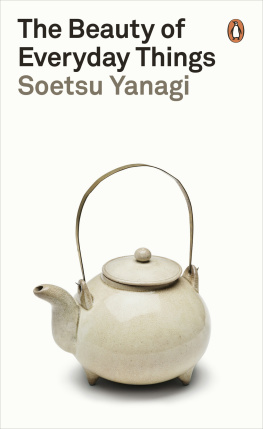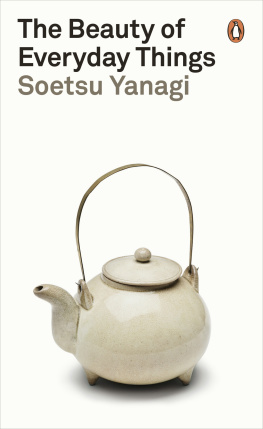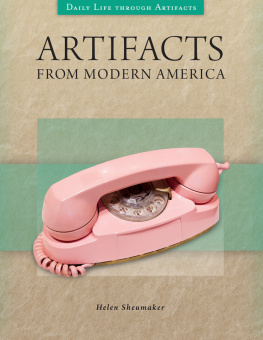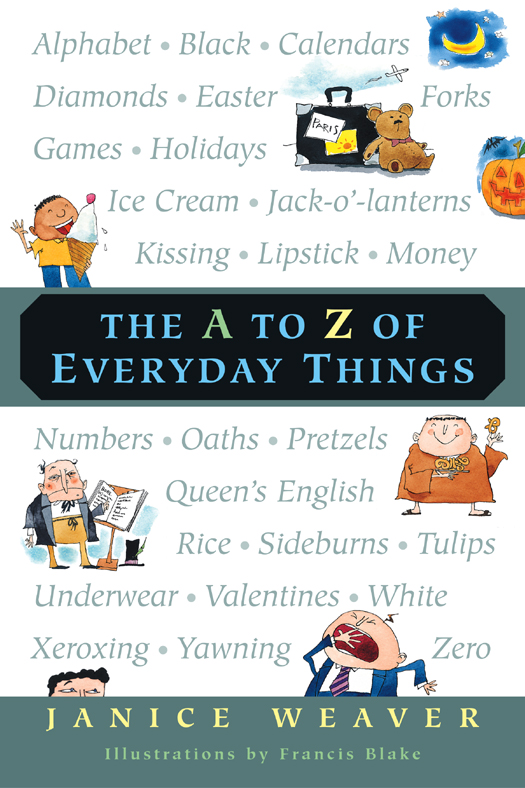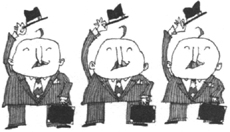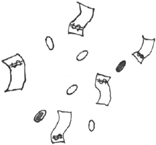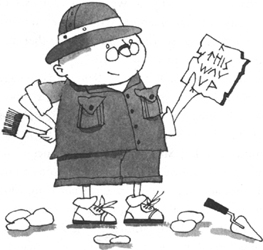Text copyright 2004 by Janice Weaver
Illustrations copyright 2004 by Francis Blake
Published in Canada by Tundra Books,
75 Sherbourne Street, Toronto, Ontario M5A 2P9
Published in the United States by Tundra Books of Northern New York,
P.O. Box 1030, Plattsburgh, New York 12901
Library of Congress Control Number: 2004105082
All rights reserved. The use of any part of this publication reproduced, transmitted
in any form or by any means, electronic, mechanical, photocopying, recording,
or otherwise, or stored in a retrieval system, without the prior written
consent of the publisher or, in case of photocopying or other reprographic
copying, a licence from the Canadian Copyright Licensing Agency
is an infringement of the copyright law.
National Library of Canada Cataloguing in Publication
Weaver, Janice
The A to Z of everyday things / Janice Weaver; illustrator, Francis Blake.
Includes bibliographical references.
eISBN: 978-1-77049-904-1
1. Handbooks, vade-mecums, etc. Juvenile literature. 2. Curiosities and wonders
Juvenile literature. I. Blake, Francis II. Title.
AG5.W39 2004 j031.02 C2004-902205-9
We acknowledge the financial support of the Government of Canada through the Book Publishing Industry Development Program (BPIDP) and that of the Government of Ontario through the Ontario Media Development Corporations Ontario Book Initiative. We further acknowledge the support of the Canada Council for the Arts and the Ontario Arts Council for our publishing program.
v3.1
For Mark, whose enthusiasm is always genuine,
even if his information is sometimes suspect
Acknowledgments
A s always, I owe a great debt to my ever-expanding circle of first readers, especially my parents, Robert and Audrey Weaver (who naturally love everything I do, but also never hesitate to tell me when I could do it better); my good friends and sounding boards Caryl Silver, Terri Nimmo, and Sun-Kyung Yi; and the many people who offered up suggestions aplenty whenever I was stuck on a letter. The folks at Tundra Books Kristy Button, Catherine Mitchell, Alison Morgan, Kong Njo, Melanie Storoschuk, Tamara Sztainbok, and Sue Tate were as supportive and encouraging as ever. I must thank, especially, my long-time friend and publisher, Kathy Lowinger, for giving me the time to get this book right.
My editor, Gena Gorrell, does triple duty as friend and mentor. Not only did she give me my first job in publishing, but she has taught me almost everything I know about careful and diplomatic editing, skills she certainly had to call on in dealing with me on this project.
I could not have finished this book without the help of the Ontario Arts Councils Writers Reserve Program and its publisher-recommenders, especially James Lorimer & Company and Maple Tree Press.
And what can I possibly say about Francis Blake? I couldnt have known, when I picked his artwork out of an agents catalogue, that I was choosing not only a creative collaborator without equal but also a wonderful new friend. He is a huge talent and a tremendous pleasure to work with, and Im grateful for everything he has brought to this book.
Introduction
A writer I really admire once said, Common things are the most important things, the ones with history and politics and meaning, the ones with clout. Shes right. There is something truly amazing about the objects we routinely take for granted. They are the things we least question or even think about but they often tell us the most about ourselves and what we believe in. There is just something extraordinary in the ordinary.
I have filled this book with stories about twenty-six of those extraordinary ordinary things, one for each letter of the alphabet. Some are seemingly simple innovations, like the calendar or zero, that have had an immeasurable impact on the way we live our lives. Others, like forks and pretzels, are just everyday objects that nevertheless tell us something about who we are now or how we used to be.
For every one of the twenty-six letters, I hope, we learn something surprising and new about the connection between Valentines Day and wolves, for example, or how pretzels helped save a city from invasion. We learn why we fear the number thirteen and how Marco Polo brought ice cream to the Western world. We discover why widows wear black, why the Easter bunny hides eggs, why broken mirrors bring bad luck, and why yawning is contagious. We even find the stories of our efforts to measure time and to capture the sounds of our speech in symbols that people separated by centuries can still understand.
Ultimately, then, this is a book about ideas. Most everything in these pages had to be invented by the human mind, just as we invented cars and electrical power and the polio vaccine. But these things are now so much a part of our daily lives that we can barely imagine a time when they didnt exist or, for that matter, conceive of the great struggle that often went into perfecting them or getting others to accept them. In fact, they have so successfully worked themselves into our everyday lives that its hard not to take them for granted. In this book, I hope to shine some light on these remarkably unremarkable things, and, in doing so, paint a sometimes surprising picture of modern life and how we got here.
A



